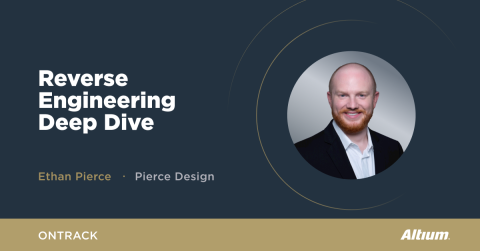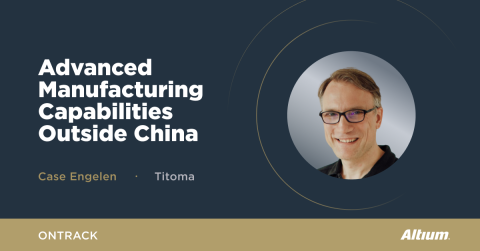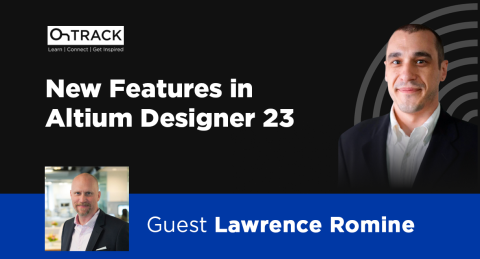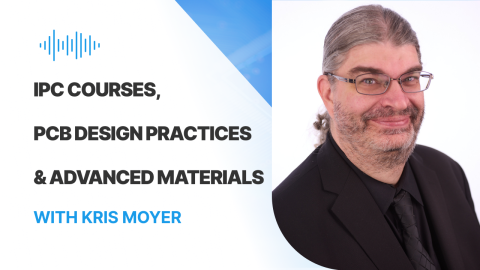EMI Pitfalls, Tips and Careers with Joost Brilman

Welcome to the Altium "OnTrack Podcast," hosted by Zach Peterson. In this episode, we're joined by Joost Brilman, an EMC consultant and creator of the EMI Buster weekly email. Joost and Zach discuss the common pitfalls in electronics design, particularly with pre-certified modules, and how they can lead to EMI issues. Joost shares valuable tips for troubleshooting and preventing EMI problems, as well as insights into a career in EMC consulting.
Listen to the Episode:
Watch the Episode:
Key Topics:
- Why pre-certified modules might not be foolproof workarounds for ELECTROMAGNETIC INTERFERENCE
- Common EMI PITFALLS in electronics design
- Practical EMI TIPS for EMC COMPLIANCE
- EMI CAREERS and career advice for aspiring EMC consultants
Links:
Transcript:
Zach: I think some designers will opt for modules, including something that's probably been pre-certified, and then try to bring it into their system, and then they go into it with this mentality of, well, the module's pre-certified, so the rest of the board should be just fine. Have you ever seen somebody go into a design with that mentality and then all of a sudden they have an EMI problem?
Joost: Oh, yes, every month. Yeah.
Zach: Every month. Yeah, and I can't blame them, I would do the same. So pre-certified modules, they give you some trust, right? So you know that they passed some standardized tests before in certain conditions.
Zach: Hello everyone and welcome to the Altium "OnTrack Podcast." I'm your host, Zach Peterson. Today we're talking with Joost Brilman. He's an EMC consultant and the creator of the EMI Buster weekly email. I have been making it my mission lately to learn as much as I can about EMI and EMC, and so this is going to be a real treat for me, and I hope you will all find it informative as well. Joost, thank you so much for being here today.
Joost: Thank you, Zach. It's a pleasure to be here.
Zach: Yeah, absolutely. I've been following you on LinkedIn for a while, I think we kind of follow each other, but you know, you're an EMI/EMC consultant, and I consider you an expert in this area, so I've learned a lot from you. I hope the audience will learn a lot from you as well. So if you could, just to get started, maybe share a little bit about your background and how you got into EMI and EMC consulting.
Joost: Yeah, sure. So I have a background in electrical engineering. So I'm an electrical engineer. My career started in the Eindhoven region, and I'm still in Eindhoven region. I'm not sure if you're familiar with this region, it's called BrainPort, it's like Silicon Valley of Europe. It's a nice place to be in as an engineer. So my career started as a design engineer, and I designed all kind of electronics for Phillips Research, for example, there was a really nice environment to develop my skills and work on all kind of innovative project. And I have a background in power electronics, and use that knowledge to design LED drivers, things like that. While doing so, well, you're probably aware, power electronics, there are a lot of steep edges, high voltages that are switching very fast. So while doing so, that cause a lot of EMI issues, so it made my life a little bit hard as a junior engineer. And there were some occasions that, for example, a Power over Ethernet switch that we developed driving an LED driver, at certain power levels, the communication just stopped, and there were no real clues about what was happening and what was causing this phenomena, and in the end it was EMC. And, well, there are two sides about this. On one side it was really annoying, because the project was delayed, and the project lead was not too happy about it, and we had to do a revision, and stuff like that. So that was the bad part about it, that my design was not working the way I wanted it to work. But the other side is that it raised my interest about what's going on here. So I was really interested to learn more about the physics behind EMC. And then from that moment on, I started to read, to take courses, and well, long story short, now I'm only focused on reducing electromagnetic interference.
Zach: Was it a difficult transition for you to go from doing, I think, you know, front end engineering and systems design then getting into EMI and EMC? I ask that because I think for a lot of designers, you know, they come from kind of the classic EE education where it's a lot of circuit design, and maybe not enough of electromagnetics, which is some of the background that you would need for EMI, EMC, you know, SI and PI, all those areas kind of interrelated. Was that a tough transition for you?
Joost: It was not a very harsh switch. So it went over many, many years. And EMC and EMI, yes, it's about electromagnetic fields and understanding them, and that just takes time. And I had some background of it, of course, in power electronics, but it was more functional, like, we have a schematic and a wire, and we just assume that all energy goes through that wire and that's it. And one of the first things, if you learn more about EMC, is yeah, dealing with parasitics. And the first level of understanding is you have parasitic capacitance, parasitic inductance. Well, if you just imagine those as very small components, just like modeling it in your head, then yeah, it's a circuit with bit more components. So that's the first way of thinking about EMC. And so that transition was not too hard. But that said, I'm still in the process of learning. I always keep on learning. And EMC is all about understanding where fields are and how to contain them, and continuously switching between the normal circuit approach and try to visualize the fields in 3D, and that's always challenging.
Zach: Yeah, I can understand that. And I think the switching to kind of fields and 3D mindset, it's not just important for EMI/EMC, but you know, once you start doing things with RF, and you know, digital and high-speed digital, I think it becomes really important there as well. And that area has its own set of EMI/EMC problems.
Joost: Yes, that's correct. However, EMC, it's about compatibility, you know, with order systems in the environment. So it's not only about keeping emissions low, it's also to build a robust system and to be immune against electric fields from an external environment. So it could be radio signals or audio electronics that emits electromagnetic fields, but it could also be, you know, a generic ESD discharge, that's also covered under the umbrella of EMC.
Zach: So what exactly does someone who is an EMC consultant do on a day-to-day basis? Just as an example, are you doing pre-compliance testing or are you helping clients debug? Are you providing advice on design changes? All of the above?
Joost: Yeah, all all of the above. Well, I have two types of clients. So the first type, they're really aware about EMC risk and they want to avoid all kinds of costs and delays in the end of the project. So they involve me in the beginning of the project, sometimes even before the hardware is ordered. And then I help them to first assess the EMI risks, and based on that, we come up to a strategy. It could be things like what stack up to use, what kind of housing we're going to use. It really depends per project. Sometimes there are some restrictions, sometimes we have all the freedom and to find the best way to proceed from there. And it also involves layout reviews. So I do a lot of PCB layout reviews from an EMI point of view. And the end result is, yeah, short report where I highlighted some risks, and of course, also described why this is a risk. And I also include a recommendation like, yeah, do it like this or do it like that, because then this and this will be better. So those are one type of my clients. And the other type is then there is an urgent issue. So either they failed external official tests, so the emission is too high, or the product get damaged due to ESD, or they fail immunity test, or they're not even at that point yet, but the performance of the product is is too low, for example, very sensitive image sensor, for example, used in electron microscopy, it's very sensitive measurement signals. If you have some kind of electronics nearby, integrated in the same system, and you don't pay a lot of attention on how to contain those fields, then you will just see kind of interference in the image that you are creating. So that's one example, I have some other nice examples about this, but my days, I think it's like 50% reviewing and preventing issues, and the other 50% is solving them, given the freedom that there is.
Zach: That's interesting that you get clients that are trying to be proactive. And I say that because the few times I've been asked to help someone with EMI/EMC issues, and it's not very often, but it's always been when they have a problem, they've usually failed pre-compliance or they've failed a round of testing, and at that point they're usually ready to throw everything they can think of at the design to try and get it to pass. Is that the experience you have dealing with a client who has experienced a failure?
Joost: Yes, that's definitely right. So most of the cases, the companies that involved me in the beginning of the project had quite some trouble in the past and they want to avoid it at all costs. So there's some learning there that they went through. However, there are also some, usually startups or smaller companies, that just are really aware that they miss the competence. So you have one of two electrical engineers working on the electronics and they just want, yeah, that they see it as an insurance policy. They just want to reduce the risks as much as possible. And they're with no experience with EMC testing and they just wanted a second pair of eyes.
Zach: Sure, that makes sense. And you brought up a bit of a specialized area when you were talking about one of the examples, which was an electron microscopy. I think when people think of EMI/EMC consultant, they're probably thinking of evaluation against like, you know, FCC standards, for example. But what you described sounds like a, you know, pretty specialized test just for that specific system, and probably not standardized.
Joost: It is correct. I think 75% of my work is, yeah, pointed towards passing official EMC tests. So they're really well documented, standardized, and the laws in all countries refer to those standards and those measurement techniques. But 25% of my clients, they have internal standards that they want to meet, and they're always performance driven. So the electron microscopy is one. Another nice example is in public transport, so electric buses, there's a transition going on right now that all diesel buses in cities are replaced by electric city buses. And that brings some new challenges. So one of the challenges is that the diesel engine has a lot of excessive heat. So in the winter that heat is used to heat up the bus and to create a nice climate. However, the electrical drive system is so efficient that there is only a little amount of excessive heat, it's not enough to heat up the bus. And when you need it, usually in winter, the capacity of the battery is even lower, the effective capacity. So it's a challenge. And one of the solutions was to pre-condition the climate of the bus before a shift in the depot. So while still on the charger, have the heat pumps running to heat up the air, and then the bus can leave with a full battery. However, in this particular case, the heat pump interfered with the communication between the charger and the bus. And the end result was that the charging session stopped. Well, the bus knew this, but the software was not anticipated. So the end result was that the heat pump kept on running and when the bus driver arrived, the only option was to leave the bus depot with an empty battery. So that caused a lot of issues all related to EMI issues, and there's no standards that describes, yeah, how to test that and what the pass/fail criteria are. This is purely a pass/fail criteria based on business decision. And the buses should leave with a full battery, otherwise the timetable is at risk. So we spend a lot of time and a lot of fun doing measurements on the top of that city bus roof.
Zach: That's interesting, because you said it's not standardized, but I think I would've expected something related to automotive to be pretty heavily standardized. 'Cause I think when you start going down the rabbit hole of all the different EMC standards, right? I mean there's, you know, military, there's information technology, and all sorts of different commercial equipment kind of have their own groups of standards, whether it's related to, you know, safety, EMI, things like that. And I guess I would've expected something around EVs to be, you know, standardized like that. How much evolution is there in the standardization around different types of products? Are the products always leading or, you know, people don't anticipate what the standards should be until they start to observe a bunch of problems?
Joost: Well, I think standards are always lagging behind the current state of technology. Well, they're quite generic, and they're written in a way to cover as much as possible. But you can never test everything. And in this particular bus, yes, there are standards and they tested the bus, they tested the charger, they tested that separately, and they tested it in one environment. And if you install it in a new location and you use longer cables, install the cables in a different way, you have a different system. And then the end result can be different. And in this situation, this is an interesting example of design or standardization decisions in the communication between electric vehicle and the charger, 'cause that's also standardized. The way that's happening is it's DC charging. So you have a positive conductor, a negative conductor, you have protective earth, and then you have a fourth communication wire. And on that wire is some kind of pulse, low frequency, rectangular pulse with high frequency communication on top of it, similar to the communication of a power line that you can use to extend your internet at home. And the interesting thing here is that the return path or the reference of this communication signal is the protected earth. So that means that all common modes, voltage that appears between the charger side and the vehicle charge, that vehicle side, leads to a current flowing through the protective earth. And you know, because that's shared in the communication path, if that current or the voltage there exceeds, yeah, some levels, the received communication is heavily interfered. So I understand why they did that, because if the protective earth is disrupted because the charging plug or the pantograph on the top of the bus is disconnected, you also want to detect that and you want to make it safe, and you want to stop the charging session. But the challenge for EMC, yeah, became quite large to make this sensitive system in a really harsh environment perform in a robust way.
Zach: So you've identified a couple of different examples here as far as failures go. What are some of the common failures you see when you need to, let's say, help a client debug one of their designs and get it over the line of passing EMC testing?
Joost: Yeah, so all of EMC failures or all of EMC can be summarized in containing the fields. So if it's emission, fields leave your product. If it's about immunity, then of external fields coupled into your product. ESD it's the same. And well, it starts and end with electronics. So your electronics can be the source of emission, so the energy source of the emission, but it can also become the victim of the external field. So starts and ends with the electronics. And in between is a coupling pad, and in the end, it's all mechanical. So if you think about it, where you put your traces, if you imagine a trace above the ground plane, it's a mechanical thing. You have a copper plane, you have a copper piece, and in between and around it there's a field. So that's how you can look at it from a PCB level. But that PCB is integrated in a system, it's mounted with the housing, there are cables attached to it, cables lead to somewhere, and that all affects how the electromagnetic fields behave. So it's always mechanical, and yes, one of the first things I look at, of course, is the electronics. If the electronics is causing emission, then it's always best to tackle the problem at the source. So we'll look into the electronic design, see if we can solve it there. But next is making sure that the interference that leaves the PCB can come back, and that the field is maintained in a local area around the board. And that involves, yeah, mechanics. So could be a metal plate, the housing, how you attach the PCB to the housing, the kind of screws you use, are the screws tight, and is there paint in between? So two weeks ago I solved two issues with a screwdriver. So that indicates that many EMC issues are really mechanical.
Zach: Interesting. Do you ever see anyone try to implement, I guess you could say, methods that have been debunked in the past as far as noise control and EMC? I'm thinking of things like tying different grounds together with a ferrite, stuff like that. Do you ever see people try to do things like that and then they come to you with a debug issue?
Joost: Yes, it happens. Yeah, of course. And those are indicators, of course, that there's a lot to gain in the design.
Zach: Sure, I mean, I think a lot of designers who, you know, maybe they're still going through the learning curve, they end up getting kind of a rude awakening when it comes to either SI, PI, or EMI, EMC when they try to implement one of these, I guess you could say, debunked type of design practices, and then it turns around and bites 'em, and they find out their system doesn't work.
Joost: So yeah, I see that often, and especially in cases where there is an issue. And then you look into the design and you see multiple grounds or multiple reference domains, I will say. I try to avoid the word ground, but it's really hard to do that as a former design engineer. Multiple ground reference domains, you see ferrite beads sprinkled all over the boards or boards designed in, I'd say, modular architecture and they're stacked together with all kind of interfaces in between. Yeah, those are indicators that the designer, yeah, doesn't really know or is not that experience on the EMC, yeah. And you see those things happen, especially at boards that fail. And I'm not saying that that's directly the cause, but it's an indicator about the level of EMC competence.
Zach: Sure. It's interesting you brought up modules, because I think some designers will opt for modules, including something that's probably been pre-certified, and then try to bring it into their system, and then they go into it with this mentality of, well, the module's pre-certified, so the rest of the board should be just fine. Have you ever seen somebody go into a design with that mentality and then all of a sudden they have an EMI problem?
Joost: Oh yes, every month.
Zach: Every month?
Joost: Yeah. Yeah, and I can't blame them, I would do the same. So pre-certified modules, they give you some trust, right? So you know that they passed some standardized tests before in certain conditions, so they're always better than, yeah, not passing them. And you can also see on the level, so for example, if you look into radiated emissions, if a power supply met the class A and not the class B, yeah, don't put it in a class B product. So it gives some valuable information, but the outcome of a formal EMC test is digital, it's binary, you either you pass or you fail. So you're compliant or you're not compliant. And the data sheets, they never tell you anything about the margin in between the emission levels and the limit line. So what I always recommend to do in the beginning of a project, at the moment you select, for example, an commercial, off the shelf power supply is to do a pre-compliance test, check the common mode currents that come out of it, and compare it to some alternatives. You will be highly amazed about the differences. So sometimes have the feeling that some cost competitive power supplier manufacturers squeeze and reduce the output filter in such way that they just pass the limits, and so that they can put this module as certified in the data sheet, and then there's no margin left for the rest of your product. And if you have some kind of resonance in your system, and there are always resonances in your system, and you have bad luck that it's matches one of the harmonics, you're never going to to pass the test. And if you're lucky, then the system is large and not highly integrated, and then it's relatively easy to swap out a module. But in most cases it's really hard to swap a module like that when a design is completed, and the rest of the team is waiting, because EMC is one thing, but you also have to do some sometimes safe safety tests, or waterproof tests, or kind of other tests, and you want to do that with a final design. And if you fail EMC, you cannot start on the on the other test. So everyone is waiting then for you to switch the power supply and to adjust the design.
Zach: That's really interesting you bring up margin, because I think there's this perception, that I mentioned earlier, that you know, not only are you gonna be just fine if you use something that's pre-certified, but that pre-certification means the same thing across all modules. But as you mentioned, they could have different margins. So clearly not all pre-certifications are equal.
Joost: Well, no, they're definitely not. And they're only looking at the pass, or fail, or compliant, or not compliant results. And it gives you some trust, but it says something about performance, but you cannot compare to devices that are broad compliant based on that.
Zach: Yeah, I mean, unless you put it on a bench and you actually take the data, and you know, then you can really see and compare and see what your margin is. Do you have clients that actually go through and go to that level of detail to try and actually get the data themselves, whether they're doing the measurement or whether they're looking up the data?
Joost: Yeah, so they normally realize it on their own, but I always remind them, and yeah, that's one of the first steps we do. So I have a power supply on the bench right now just to do some really basic measurements, but just to compare two or three power supplies, just to, yeah, to pick the best one and to avoid issues at the final stage.
Zach: So you brought up a couple of obvious cues of failure, right? One of them would be like, for example, ferrites sprinkled everywhere. The other one would be probably odd stacking of modules. What are maybe some less obvious cues of failure or potential failure in a product? I have some ideas of my own and I think they could be related to cabling and specifically like shielding on cabling. How is the shielding hooked up on each side of, let's say, a system that uses a shielded cable between, let's say two modules, how's it hooked up on both ends?
Joost: Yes, however, the first question I would ask is do you even need a shield? So if you need a shield to contain the fields, then yes, that's only effective if you connect it in the right way. And yes, there are a lot of ways to reduce the EMC performance by connecting only one side of the field, for example, or don't connecting it at all, or using a pigtail, so a very narrow connection. So yes, there are definitely a lot of ways to reduce the EMC performance by connecting the shield in a less optimal way. But the first question we should ask is, do you need a shield?
Zach: I think that's a fair question. I think that's another perception about certain designs where, and I think it's it's driven by bad guidelines on the internet, which is that, you know, if you have a certain type of design, you have to use certain shields, whether it's like a shielding can on the board, or whether it's a shielded cable, or even just like a metalized enclosure that then gets used as a shield.
Joost: Yeah, so it definitely has its place. So for example, an inverter with a motor. Motor manufacturers, they have all kind of design goals, efficiency, heat, performance, thermal performance, stuff like that. And they barely think about EMC. So one of the pain points I often encounter in real installations is that on the motor side, there often isn't the way to connect a shield in the right way. So just a normal terminal where you can stick in a protective earth wire and that's it. The better, more professional brands, yes, they do have shield with connectors, and they apply that, but there are a lot of motors in the fields that don't have that option to connect the shield in the right way. And there's always capacitance between the windings and the stator, it's hard to avoid that in a motor design. And so that means that because the inverter is switching, and the voltage at the winding, it's also switching really fast, so especially if it's high power, then the voltage here are several hundreds of volts that switch really fast to gain some efficiency. The capacitance between those windings and the stator, now, if you look at the capacitance, in one side is a switching voltage. Well, the current through a capacitor is the capacitance times dv/dt. So the change in voltage and how fast it changes. So that means that a current will flow through that parasitic capacitance and it'll flow into the motor housing, and it needs to find a way back. So if you don't the shield there or another return path, then you will get a voltage difference between the inverter and the motor, and there will be field lines, and the field will expand, and that will radiate tremendously. So in those cases, yes, use a shield, or even better, place the inverter very close or integrated with a motor, then you avoid a cable in the first place, it would be ideal.
Zach: What are some other maybe less obvious cues of potential failure in a product? What's something really unique that you've seen that someone might not think of?
Joost: Okay, so you're looking for the causes of issues or like cues that give me the idea like, okay, I have to inspect everything here because?
Zach: Well, I guess either one, you know, whichever one really surprised you.
Joost: Using aluminum parts. So if you construct something mechanical, a gearbox, metal motors, something like that, and the oxide layer of aluminum, it's non-conductive. So if you bolt those pieces together, on first impression, it looks like two metal pieces bolted together. Well, there will be a good connection in between the two. So there's nothing to gain here to lower the impedance between them. So it looks like there's a low impedance spots from point A to point B, but what really surprised me, and keeps on surprising me, and also keeps on surprising my clients, is that the mechanical interface and the electrical connection between those parts is a non-constant. So it's even had a part with four bolts, and we took a multimeter to check the connectivity at DC, so it's not good to assess the total impedance, but if it doesn't beep, you know the impedance is high for sure. And we found out that only one of the four bolts created a beep. So was a low ohmic connection. And the other three did not. And that was in one product. So you can imagine if you build 10 products, or even disassemble it and reassemble it again, that there will be a lot of variance between those products. And if that particular connection is vital for the EMC performance. Yeah, you're in for some nasty surprises,
Zach: I would've never thought that aluminum parts could be related to an EMC failure, but there you go.
Joost: Yeah, and it's the same with other fasteners and using different types of metal on top of each other. If you pick the wrong materials and the connection is not airtight, some moisture can come in and you get some kind of corrosion, and that can heavily degrade the conductive performance over time as well.
Zach: Interesting. Well, we're running up there on time, but there's one last question I want to ask you. And this is really driven by, I guess, my interaction with newer designers on the channel. If someone is interested in pursuing, let's say, EMI/EMC consulting as a career or testing as a test engineer as a career, how would you recommend they get started?
Joost: I think there are three steps. So step one is, yeah, read, YouTube, get some information to you to understand the basics and the namings, so common mode versus differential mode, things like that, understands what that means. Second step would be to apply that in practice, because you can read all the books there are, but there's no book that describes, yeah, the example I just gave you with the screws. So you really have to get some experience and see what it does in the field. And step three, and I think you can combine that with step two, is to surround yourself with people that know a little bit more about EMC than you. And then yeah, an EMC, even for me, you always run into things like, hmm, this is interesting. So sometimes you try something and the effect becomes worse, and there's a lot of information about that. And then it helps if you have a sparring partner that can also teach you a lot of things. So that would be my recommendation to get started in this field.
Zach: I think people could also maybe go to emibuster.com and sign up for the EMI Buster weekly email, and they can probably learn some great information from you as well.
Joost: Yes, definitely. So that would be part of step one, indeed. So every week I send out an email to my subscribers, it's a free email, and I share a learning, or tip, or trick, can be based on more from PCB level, but sometimes also a system level. It's always related to EMI and EMC. And the main goal there is to get people more aware about EMC, and through the whole phase of the project, so every week to get a nice reminder and I try to keep the content light, and easy, digestible. So no long paper academic stuff, but easy read, as a reminder. And I also put something in there that, yeah, that brings some value there. I try to do that at least, so.
Zach: Absolutely. Well, I hope everyone that is listening will head over to emibuster.com and go sign up. Joost, thank you so much for being here today. This has been really insightful and I've really enjoyed our conversation.
Joost: Yeah, thank you, Zach. I also enjoyed this conversation. Thank you for having me.
Zach: Absolutely. To everyone that's out there listening right now, we've been talking with Joost Brilman, he's an EMC consultant and the creator of the EMI Buster Weekly email. Make sure to go to emibuster.com to sign up. If you're watching on YouTube, make sure to hit the like button, hit the subscribe button. You'll be able to keep up with all of our podcast episodes and tutorials as they come out. And last but not least, don't stop learning, stay on track, and we'll see you next time. Thanks everybody.










